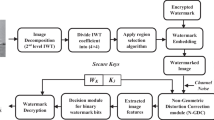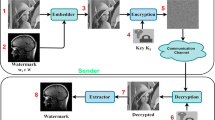Abstract
Recently, embedding a large amount of secret data into gray-level and color images with low distortion has become an important research issue in steganography. In this paper, we propose a data embedding scheme by using a well-known genetic algorithm, block truncation code and modification direction techniques to embed secret data into compression codes of color images to expand the variety of cover media. In the scheme, the common bitmap generation procedure of GA-AMBTC has been modified to speed up the hiding procedure. Two embedding strategies are proposed to hide secret data into the common bitmap and the quantization values in each block of the cover image. Experimental results confirm that the proposed scheme can provide high data capacity with acceptable image quality of the stego-images. Moreover, the compression ratio of the scheme is exactly the same as that of GA-AMBTC so that attackers cannot detect any trace of hidden data from the size of the modified compressed result.
Similar content being viewed by others
References
Bender W, Gruhl D, Morimoto N, Lu A (1996) Techniques for data hiding. IBM Syst J 35(3&4): 313–336
Chan CK, Cheng LM (2004) Hiding data in images by simple LSB substitution. Pattern Recognit 37(3): 469–474
Chang CC, Hsiao JY, Chan CS (2003) Finding optimal least- significant-bit substitution in image hiding by dynamic programming strategy. Pattern Recognit 36(7): 1583–1593
Chang CC, Hu YC (1999) Hybrid image compression methods based on vector quantization and block truncation coding. Opt Eng 38(4): 591–598
Chang CC, Lin CY, Wang YZ (2006) New image steganographic methods using run-length approach. Inform Sci 176(22): 3393–3408
Chang CC, Tai WL, Lin CC (2006) A reversible data hiding scheme based on side match vector quantization. IEEE Trans Circuits Syst Video Technol 16(10): 1301–1308
Chen B, Latifi S, Kanai J (1999) Edge enhancement of remote image data in the DCT domain. Image Vis Comput 17(12): 913–921
Chen WJ, Tai SC (1999) A genetic algorithm approach to multilevel absolute moment block truncation coding. IEICE Trans Fundam Electron Commun Comput Sci E82-A(8): 1456–1462
Chuang JC, Chang CC (2006) Using a simple and fast image compression algorithm to hide secret information. Int J Comput Appl 28: 1735–1743
Cox IJ, Kilian J, Leigiton T, Shamoon T (1997) Secure spread spectrum watermarking for multimedia. IEEE Trans Image Process 6(12): 1673–1687
Du WC, Hsu WJ (2003) Adaptive data hiding based on VQ compressed images. IEE Proc Vis Image Signal Process 150(4): 233–238
Hsu CT, Wu JL (1999) Hidden digital watermarks in images. IEEE Trans Image Process 8(1): 58–68
Hu YC, Chang CC (1999) Quadtree-segmented image coding schemes using vector quantization and block truncation coding. Opt Eng 39(2): 464–471
In J, Hsiarani S, Kossentini F (1999) On RD optimized progressive image coding using JPEG. IEEE Trans Image Process 8(11): 1630–1638
Kamstra LH, Henk JAM (2005) Reversible data embedding into images using Wavelet t-techniques and sorting. IEEE Trans Image Process 14(12): 2082–2090
Kim T (1992) Side match and overlap match vector quantizers for images. IEEE Trans Image Process 1(2): 170–185
Konstantinides K, Bhaskaran V, Beretta G (1999) Image sharpening in the JPEG domain. IEEE Trans Image Process 8(6): 874–878
Lee YK, Chen LH (2000) High capacity image steganographic model. IEE Proc Vis Image Signal Process 147(3): 288–294
Lin SD, Shie SC (2000) Side-match finite-state vector quantization with adaptive block classification for image compression. IEICE Trans Inform Syst E83-D(8): 1671–1678
Lin YC, Tai SC (1998) A fast linde-buzo-gray algorithm in image vector quantization. IEEE Trans Circuits Syst II: Analog Digit Signal Process 45(3): 432–435
Lu CS, Huang SK, Sze CJ, Liao HYM (2000) A new watermarking technique for multimedia protection. In: Ling G, Jan L, Kung SY (eds) Multimedia image and video processing, Chap. 18. CRC Press, Boca Raton, pp 507–530
Lu ZM, Sun SH (2000) Digital image watermarking technique based on vector quantization. Electron Lett 36(4): 303–305
Lin YC, Wang CC (1999) Digital images watermarking by vector quantization. In: Proceedings of 9th National Computer Symposium, Taichung, Taiwan, pp 76–87
Munteanu A, Cornelis J, Auwera GVD, Cristea P (1999) Wavelet image compression—the quadtree coding approach. IEEE Trans Technol Biomed 3(3): 176–185
Nasrabadi NM, King RA (1988) Image coding using vector quantization: a review. IEEE Trans Commun 36(8): 957–971
Pai YT, Ruan SJ (2006) Low power block-based watermarking algorithm. IEICE Trans Inform Syst E89-D(4): 1507–1514
Pan JS, Huang HC, Jain LC (2004) Intelligent watermarking techniques. World Scientific Publishing Company, Singapore
Pfitzman B (1996) Information hiding terminology, Information Hiding: First International Workshop. Springer Lecture Notes in Computer Science, Cambridge, UK, vol 1174, pp 347–350
Rivest R, Shamir A, Adleman L (1978) A method for obtaining digital signatures and public-key cryptosystems. Commun ACM 21(2): 120–126
Shie SC, Lin SD, Fang CM (2006) Adaptive data hiding based on SMVQ prediction. IEICE Trans Inform Syst E89-D(1): 358–362
Shieh CS, Huang HC, Wang FH, Pan JS (2004) Genetic watermarking based on transform domain techniques. Pattern Recognit 37(3): 555–565
Tai SC, Chen WJ, Cheng PJ (1998) Genetic algorithm for single bit-map AMBTC coding of color images. Opt Eng 37(9): 2483–2490
Walker JS (1996) Fast Fourier transforms, 2nd edn. CRC Press, Boca Raton, FL
Wang RZ, Lin CF, Lin JC (2001) Image hiding by optimal LSB substitution and genetic algorithm. Pattern Recognit 34(3): 671–683
Zhang XP, Wang SZ (2006) Efficient steganographic embedding by exploiting modification direction. IEEE Commun Lett 10(11): 1–3
Author information
Authors and Affiliations
Corresponding author
Rights and permissions
About this article
Cite this article
Chang, CC., Chen, YH. & Lin, CC. A data embedding scheme for color images based on genetic algorithm and absolute moment block truncation coding. Soft Comput 13, 321–331 (2009). https://doi.org/10.1007/s00500-008-0332-x
Published:
Issue Date:
DOI: https://doi.org/10.1007/s00500-008-0332-x




